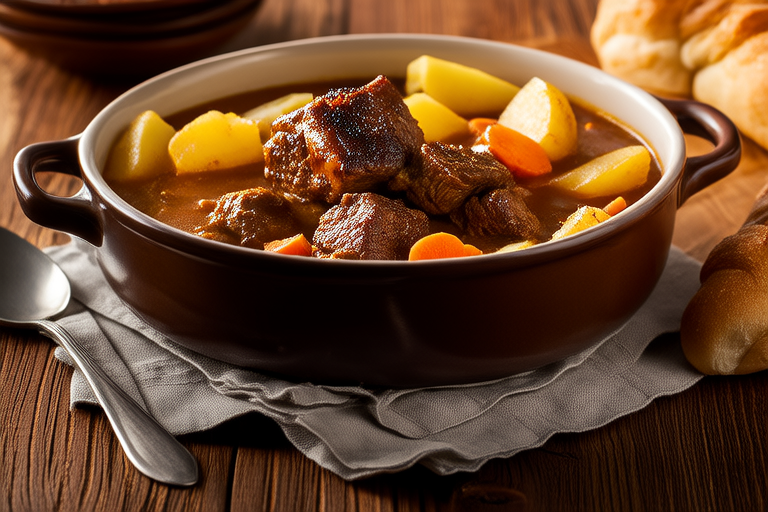Comfort in Every Bite: Classic Beef Stew
Introduction
Classic Beef Stew is not just a dish; it’s a culinary journey that takes you back to the comfort of home, where warmth and love are infused into every bite. This hearty, slow-cooked stew is a timeless favorite, cherished for its rich flavors and nostalgic appeal. In this article, we will explore the art of making the perfect beef stew, from selecting the right cuts of meat to crafting the ideal broth and garnishing the final dish.
This recipe is designed to bring out the best in your ingredients, ensuring a dish that is both comforting and satisfying. Whether you’re a seasoned chef or a novice in the kitchen, this guide will provide you with the tools and techniques to create a classic beef stew that will warm your heart and satisfy your palate.
In this comprehensive guide, we’ll cover everything from choosing the right cuts of beef to the importance of seasoning and simmering. We’ll also explore the history of beef stew and how it has evolved over time. By the end of this article, you’ll have all the knowledge you need to make a delicious and comforting beef stew that will leave your guests asking for more.
Ingredients
To make the perfect beef stew, you’ll need high-quality ingredients that will stand up to long cooking times. Here’s what you’ll need:
- 2 pounds of beef chuck roast, cut into 1-inch cubes
- 2 tablespoons of olive oil
- 4 cups of beef broth
- 2 medium onions, chopped
- 4 cloves of garlic, minced
- 2 carrots, peeled and sliced
- 2 celery stalks, sliced
- 3 russet potatoes, peeled and cubed
- 1 cup of pearl onions, peeled
- 1/2 cup of frozen peas
- 2 tablespoons of tomato paste
- 2 tablespoons of all-purpose flour
- 1 teaspoon of dried thyme
- 1 teaspoon of dried rosemary
- 1 bay leaf
- Salt and pepper, to taste
- 2 tablespoons of butter (optional)
Instructions
Step 1: Prepare the Meat
The first step in making a great beef stew is to prepare the meat properly. Start by cutting the beef chuck roast into 1-inch cubes. This ensures that the meat will cook evenly and absorb the flavors of the broth. Pat the meat dry with paper towels to remove excess moisture, which will help achieve a nice sear.
Next, season the meat generously with salt and pepper. The seasoning will not only enhance the flavor of the meat but also help create a flavorful crust when you brown it. Let the meat sit at room temperature for about 30 minutes before cooking. This allows the seasoning to penetrate the meat and ensures even cooking.
Step 2: Sear the Meat
Heat 1 tablespoon of olive oil in a large Dutch oven or heavy-bottomed pot over medium-high heat. Once the oil is hot, add half of the seasoned beef cubes. Brown the meat on all sides, about 4-5 minutes per side. Be patient during this step; browning the meat is crucial for developing flavor. Once browned, transfer the meat to a plate and repeat with the remaining beef, adding another tablespoon of olive oil if necessary.
Step 3: Cook the Vegetables
Add the remaining tablespoon of olive oil to the pot. Reduce the heat to medium and add the chopped onions, garlic, carrots, and celery. Cook for about 5 minutes, stirring occasionally, until the vegetables begin to soften and become fragrant. This step adds depth to the stew by incorporating the natural sugars from the vegetables.
Step 4: Deglaze and Add Seasonings
Once the vegetables are cooked, pour in the beef broth and scrape up any browned bits from the bottom of the pot. These bits contain concentrated flavor, so don’t skip this step! Stir in the tomato paste, thyme, rosemary, and bay leaf. The tomato paste will give the stew a rich, savory base, while the herbs will add complexity to the overall flavor profile.
Step 5: Simmer the Stew
Return the seared beef to the pot, along with any accumulated juices. Bring the stew to a simmer over medium heat, then reduce the heat to low. Cover the pot and let it simmer gently for about 1.5 hours, or until the beef is tender. Stir occasionally to ensure even cooking. If you prefer a thicker stew, you can mix 2 tablespoons of all-purpose flour with a little water and stir it into the stew during the last 30 minutes of cooking.
Step 6: Add Potatoes and Peas
About 30 minutes before the stew is done, add the cubed potatoes and pearl onions to the pot. Continue to simmer until the potatoes are tender but still hold their shape. Finally, stir in the frozen peas during the last 10 minutes of cooking to ensure they retain their bright green color and crisp texture.
Step 7: Garnish and Serve
Taste the stew and adjust the seasoning with additional salt and pepper if needed. You can also add a pat of butter to each serving for extra richness and creaminess. Serve the stew hot, garnished with fresh parsley or thyme sprigs if desired. Pair it with crusty bread or a side salad for a complete meal.
History and Cultural Significance
Beef stew has been a staple in many cultures for centuries. Its origins can be traced back to ancient times when people would use tough cuts of meat, such as beef chuck, to create hearty, nourishing meals. The slow-cooking process was essential to break down the connective tissue in the meat, making it tender and flavorful. Over time, beef stew became a symbol of comfort and sustenance, often associated with family gatherings and holidays.
In medieval Europe, beef stew was a common dish among peasants and laborers who could afford only inexpensive cuts of meat. As the dish gained popularity, regional variations emerged, incorporating local ingredients and spices. Today, beef stew remains a beloved comfort food around the world, appreciated for its simplicity and versatility.
Health Benefits
Beef stew is not only delicious but also nutritious. It provides a good source of protein, iron, and other essential nutrients. The combination of lean beef, vegetables, and whole grains makes it a balanced and wholesome meal. Additionally, the slow-cooking method helps preserve the nutrients in the ingredients, ensuring that you get the most out of your meal.
Tips for Success
- Choose the right cut of beef. Beef chuck is ideal for stew because it contains plenty of collagen, which breaks down during cooking to produce a rich, flavorful broth.
- Don’t overcrowd the pot. If you’re cooking a large batch, do it in batches to ensure that the meat browns properly.
- Use a quality broth. Homemade beef broth will add depth and richness to your stew, but store-bought broth works well too.
- Let the stew rest. After cooking, let the stew sit for about 10 minutes before serving. This allows the flavors to meld together and the liquid to thicken slightly.
Conclusion
Classic Beef Stew is a dish that brings people together, offering comfort and warmth with every bite. By following these steps and tips, you can create a delicious and satisfying beef stew that will be a hit at your next gathering. Whether you’re making it for a cozy dinner at home or sharing it with friends, this hearty meal is sure to please. Enjoy the process of cooking and savor the flavors of this timeless classic.


